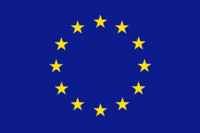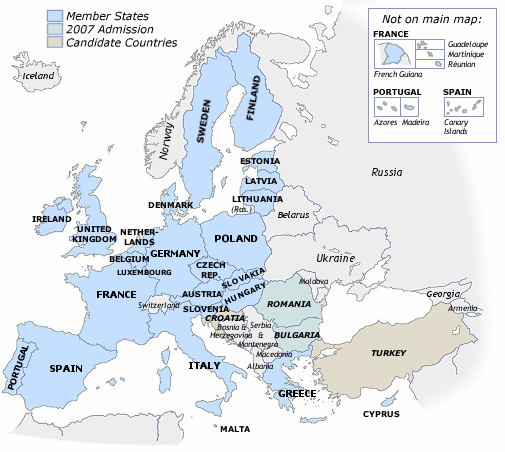 The European Union or EU is a supranational organisation of European countries, which currently has 25 member states . The Union was established under that name by the Treaty on European Union (commonly known as the Maastricht Treaty ) in 1992 . However, many aspects of the EU existed before that date through a series of predecessor organisations, dating back to the 1950s .
The European Union or EU is a supranational organisation of European countries, which currently has 25 member states . The Union was established under that name by the Treaty on European Union (commonly known as the Maastricht Treaty ) in 1992 . However, many aspects of the EU existed before that date through a series of predecessor organisations, dating back to the 1950s .
The European Union's activities cover all policy areas, from health and economic policy to foreign affairs and defence . However, the nature of its powers differs between areas. Depending on the powers transferred to it by its member states , the EU therefore resembles a federation (e.g. monetary affairs, agricultural, trade and environmental policy), a confederation (e.g. in social and economic policy, consumer protection, internal affairs), or an international organisation (e.g. in foreign affairs). A key activity of the EU is the establishment and administration of a common single market , consisting of a customs union , a single currency (adopted by 12 of the 25 member states), a Common Agricultural Policy and a Common Fisheries Policy .
On 29 October 2004 , European heads of state signed a treaty establishing the first constitution for the European Union, which is currently awaiting ratification by individual member states.
Status
The European Union is the most powerful regional organisation in existence. As seen above, in certain areas where member states have transferred a degree of sovereignty to the Union the EU begins to resemble a federation or confederation . However, the member states remain the Masters of the Treaties, meaning that the Union does not have the power to transfer additional powers from the member states onto itself, without their agreement. Also the various member states maintain their own policies in key areas of national interest such as foreign relations and defence.
On account of this unique structure, the European Union is perhaps best seen as neither an international organisation nor a confederation or even federation, but rather a sui generis entity.
The current and future status of the European Union is the subject of great political concern within some European Union member states .
Legal base
The legal base of the European Union is a sequence of treaties between its member states. These have been much amended over the years, with each new treaty amending and supplementing earlier ones. The first such treaty was the Treaty of Paris of 1951 which established the European Coal and Steel Community between an original group of six European countries. This treaty has since expired, its functions taken up by subsequent treaties. On the other hand, the Treaty of Rome of 1957 is still in effect, though much amended since then, most notably by the Maastricht treaty of 1992 , which first established the European Union under that name. The most recent amendments to the Treaty of Rome were agreed as part of the Treaty of Accession of the 10 new member states, which entered into force on 1 May 2004 .
The EU member states have recently agreed to the text of a new constitutional treaty that, if ratified by the member states, will become the first official constitution of the EU, replacing all previous treaties with a single document.
If the Constitutional Treaty fails to be ratified by all member states, then it might be necessary to reopen negotiations on it. Most politicians and officials agree that the current pre-Constitution structures are inefficient in the medium term for a union of 25 (and growing) member states. Senior politicians in some member states (notably France) have suggested that if only a few countries fail to ratify the Treaty, then the rest of the Union should proceed without them, possibly creating an "Avant Garde" or Inner Union of more committed member states to proceed with "an ever-deeper, ever-wider union".
Structure
European Union law comprises a large number of overlapping legal and institutional structures. This is a result of its being defined by successive international treaties. In recent years, considerable efforts have been made to consolidate and simplify the treaties, culminating with the final draft of the Treaty establishing a Constitution for Europe . If this proposed treaty is adopted, it will replace the set of overlapping treaties that form the current constitution of the EU with a single text.
The role of the European Community within the Union
The term European Community (or Communities) was used for the group of members prior to the establishment of the European Union. At present, the term continues to have significance, but in a different context. The "European Community" is one of the three pillars of the European Union , being both the most important pillar and the only one to operate primarily through supranational institutions. The other two pillars – Common Foreign and Security Policy , and Police and Judicial Co-operation in Criminal Matters – are looser intergovernmental groupings. Confusingly, these latter two concepts are increasingly administered by the Community (as they are built up from mere concepts to actual practice).
What most people think of as the European Union is essentially the European Community. The Community is an actual body, including the European institutions ( European Parliament , Council of the European Union, European Commission), whilst the European Union is a less tangible grouping of institutions and agreements.
If it is ratified, the proposed new Treaty establishing a Constitution for Europe would abolish this dual structure, bringing all the Community's activities under the auspices of the European Union and transferring the Community's legal personality to the Union.
Institutional framework
The European Union has several institutions:
- The European Parliament (732 members)
- The Council of the European Union (or 'Council of Ministers') (25 members)
- The European Commission (25 members)
- The European Court of Justice (incorporating the Court of First Instance ) (15 judges)
- The European Court of Auditors (25 members)
The European Council (25 members) is not an institution, but a "quasi-institution".
There are several financial bodies:
- European Central Bank (which alongside the national Central Banks , composes the European System of Central Banks )
- European Investment Bank (including the European Investment Fund )
The treaties have also established several advisory committees to the institutions:
- Committee of the Regions , advising on regional issues.
- Economic and Social Committee , advising on economic and social (principally relations between workers and employers)
- Political and Security Committee , established in the context of the Common Foreign and Security Policy , monitoring and advising on international issues of global security.
There is also a great number of bodies which were established by secondary legislation (i.e. not by the treaties) in order to implement particular policies. These are the agencies of the European Union . Some of these are the European Environment Agency , the European Aviation Safety Agency and the Office for Harmonisation in the Internal Market . In the context of the third pillar ( Police and Judicial Co-operation in Criminal Matters ), Europol and Eurojust have been created.
Lastly, the European Ombudsman watches for abuses of power by EU institutions.
Intergovernmentalism and supranationalism
A basic tension exists within the European Union between intergovernmentalism and supranationalism . Intergovernmentalism is a method of decision-making in international organisations where power is possessed by the member-states and decisions are made by unanimity. Independent appointees of the governments or elected representatives have solely advisory or implementational functions. Intergovernmentalism is used by most international organisations today.
An alternative method of decision-making in international organisations is supranationalism. In supranationalism power is held by independent appointed officials or by representatives elected by the legislatures or people of the member states. Member-state governments still have power, but they must share this power with other actors. Furthermore, decisions are made by majority votes, hence it is possible for a member-state to be forced by the other member-states to implement a decision against its will.
Some forces in European Union politics favour the intergovernmental approach, while others favour the supranational path. Supporters of supranationalism argue that it allows integration to proceed at a faster pace than would otherwise be possible. Where decisions must be made by governments acting unanimously, decisions can take years to make, if they are ever made. Supporters of intergovernmentalism argue that supranationalism is a threat to national sovereignty, and to democracy, claiming that only national governments can possess the necessary democratic legitimacy. Intergovernmentalism has historically been favoured by France, and by more Eurosceptic nations such as Britain , Denmark and Estonia ; while more integrationist nations such as Belgium , Germany , and Italy have tended to prefer the supranational approach.
The European Union attempts to strike a balance between two approaches. This balance however is complex, resulting in the often labyrinthine complexity of its decision-making procedures.
Starting in March 2002, a Convention on the Future of Europe again looked at this balance, among other things, and proposed changes. These changes were discussed at an Intergovernmental Conference ( IGC ) in May 2004 and agreement reached on a Constitutional Treaty, which will require ratification by each of the member states.
Supranationalism is closely related to the intergovernmentalist vs. neofunctionalist debate. This is a debate concering why the process of integration has taken place at all. Intergovernmentalists argue that the process of EU integration is a result of tough bargaining between states. Neofunctionalism, on the other hand, argues that the supranational institutions themselves have been a driving force behind integration. For further information on this see the page on Neofunctionalism .
Main policies
As the changing name of the European Union (from European Economic Community to European Community to European Union) suggests, it has evolved over time from a primarily economic union to an increasingly political one. This trend is highlighted by the increasing number of policy areas that fall within EU competence: political power has tended to shift upwards from the member states to the EU.
This picture of increasing centralisation is counter-balanced by two points.
First, some member states have a domestic tradition of strong regional government. This has led to an increased focus on regional policy and the European regions . A Committee of the Regions was established as part of the Treaty of Maastricht .
Second, EU policy areas cover a number of different forms of co-operation.
- Autonomous decision making: member states have granted the European Commission power to issue decisions in certain areas such as competition law , State Aid control and liberalisation .
- Harmonisation: member state laws are harmonised through the EU legislative process, which involves the European Commission , European Parliament and Council of the European Union . As a result of this European Union Law is increasingly present in the systems of the member states.
- Co-operation: member states, meeting as the Council of the European Union agree to co-operate and co-ordinate their domestic policies.
The tension between EU and national (or sub-national) competence is an enduring one in the development of the European Union.
All prospective members must enact legislation in order to bring them into line with the common European legal framework, known as the Acquis Communautaire . (See also European Free Trade Association (EFTA), European Economic Area (EEA) and Single European Sky ).
Single market
Internal aspects
- Free trade of goods and services among member states (an aim further extended to three of the four EFTA states by the European Economic Area , EEA)
- A common EU competition law controlling anti-competitive activities of companies (through antitrust law and merger control) and member states (through the State Aids regime).
- The Schengen treaty allowed removal of internal border controls and harmonisation of external controls between its member states. This excludes the UK and Ireland, which have derogations, but includes the non-EU members Iceland and Norway .
- Freedom for citizens of its member states to live and work anywhere within the EU, provided they can support themselves (also extended to the other EEA states).
- Free movement of capital between member states (and other EEA states).
- Harmonisation of government regulations, corporations law and trademark registrations.
- A single currency, the Euro (excluding the UK , and Denmark , which have derogations). Sweden , although not having a specific opt-out clause, has not joined the ERM II, voluntarily excluding itself from the monetary union.
- A large amount of environmental policy co-ordination throughout the Union.
- A Common Agricultural Policy and a Common Fisheries Policy .
- Common system of indirect taxation , the VAT , as well as common customs duties and excises on various products.
- Funding for the development of disadvantaged regions (structural and cohesion funds).
- Funding for research .
External aspects
- A common external customs tariff, and a common position in international trade negotiations.
- Funding for programmes in candidate countries and other Eastern European countries, as well as aid to many developing countries.
Co-operation and harmonisation in other areas
- Freedom for its citizens to vote in local government and European Parliament elections in any member state.
- Co-operation in criminal matters, including sharing of intelligence (through EUROPOL and the Schengen Information System ), agreement on common definition of criminal offences and expedited extradition procedures.
- A common foreign policy as a future objective, however this has some way to go before being realised. The divisions between the member states (in the letter of eight ) and then-future members (in the Vilnius letter ) during the run up to the 2003 invasion of Iraq highlights just how far off this objective could be before it becomes a reality.
- A common security policy as an objective, including the creation of a 60,000-member European Rapid Reaction Force for peacekeeping purposes, an EU military staff and an EU satellite centre (for intelligence purposes).
- Common policy on asylum and immigration.
- Common funding of research and technological development, through four-year Framework Programmes for Research and Technological Development. The Sixth Framework Programme is running from 2002 to 2006.





